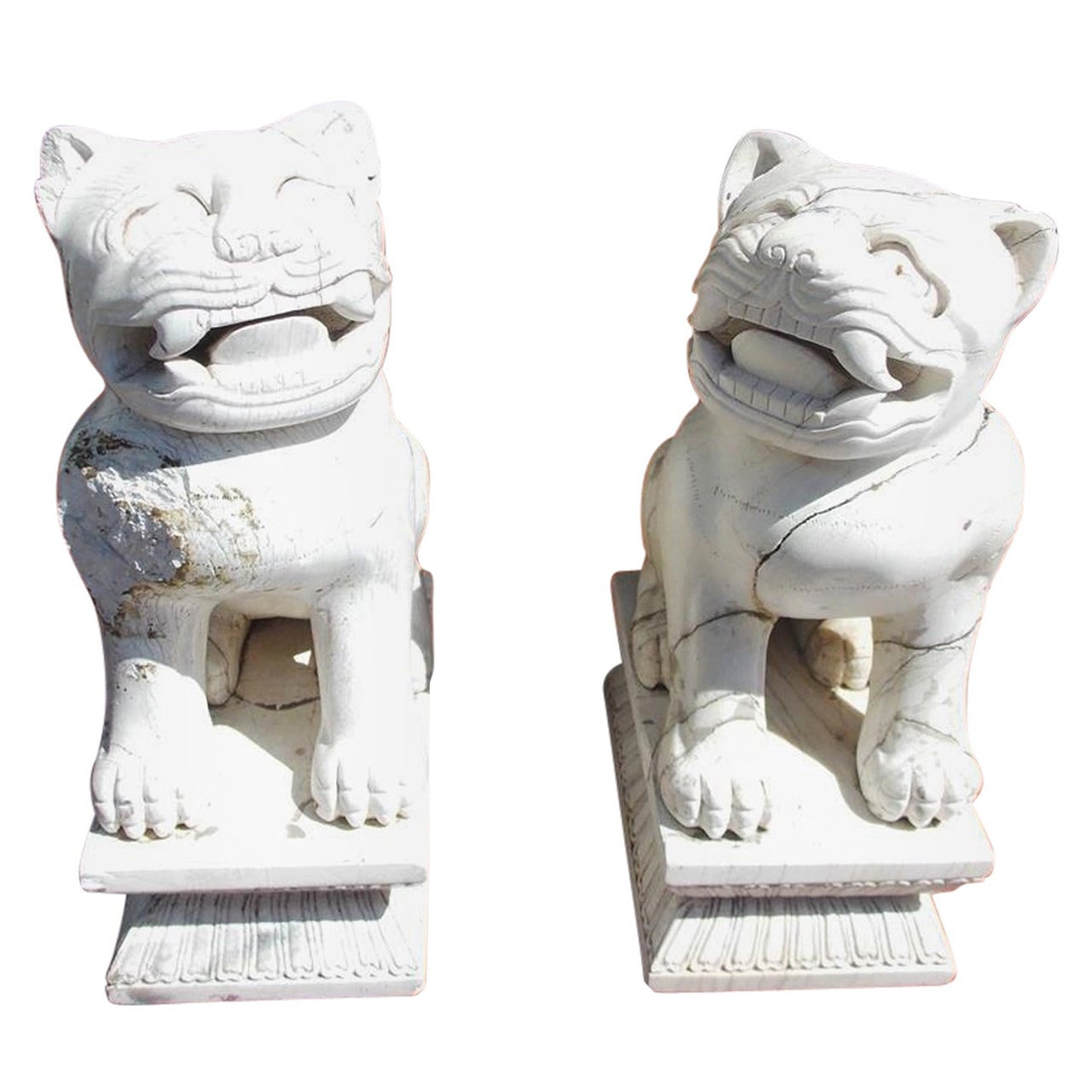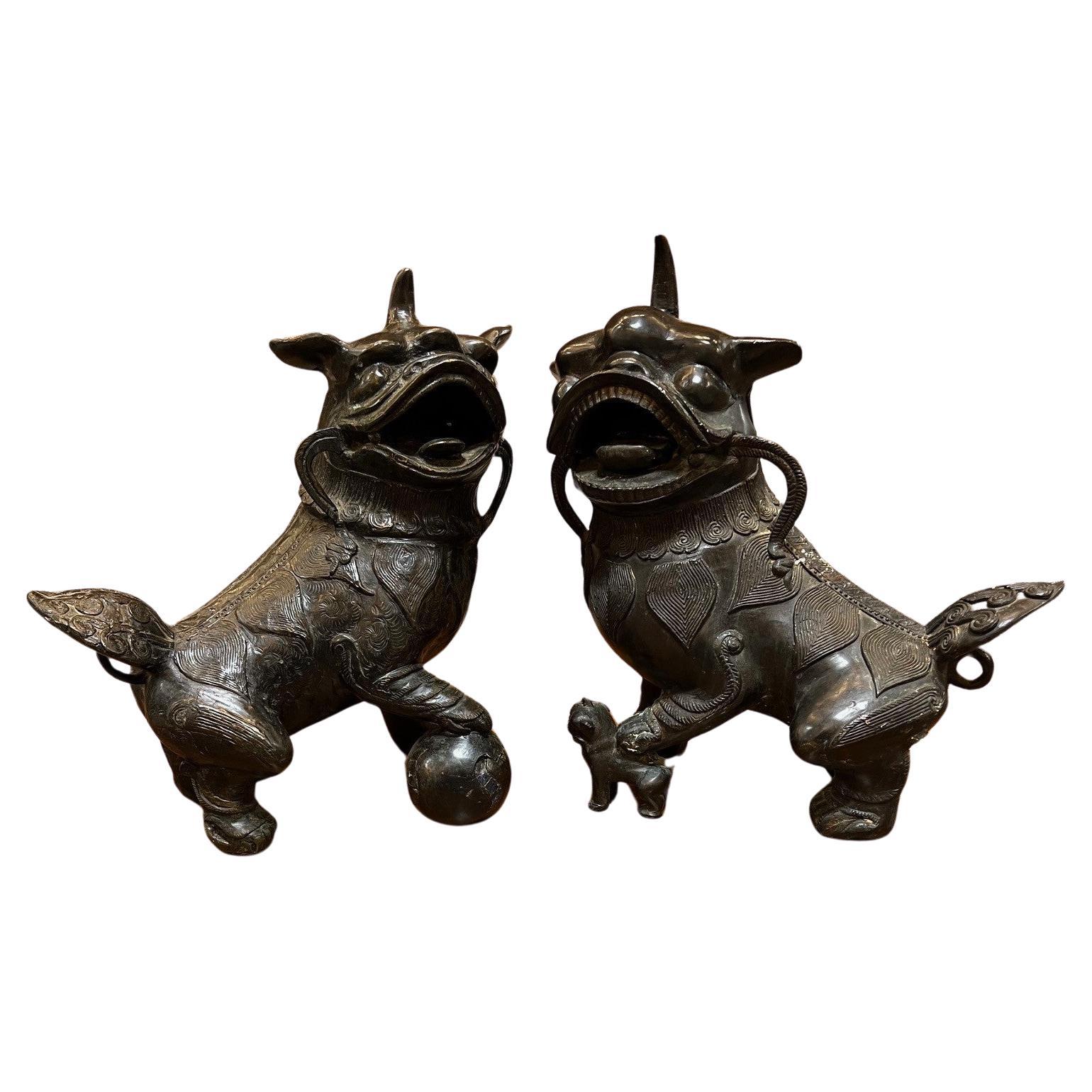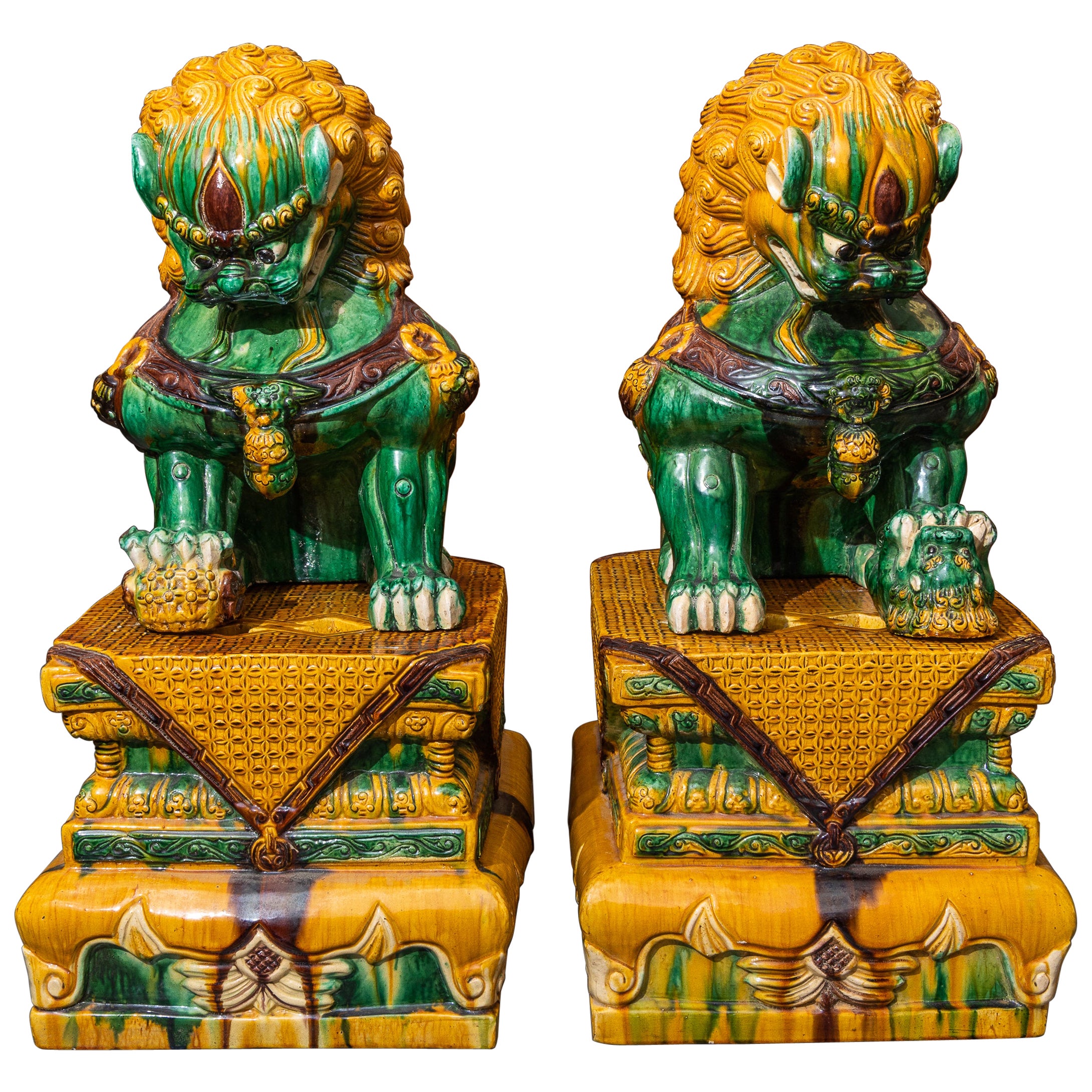Items Similar to Pair of Mid 20th Century Glazed Terracotta Foo Dogs
Video Loading
Want more images or videos?
Request additional images or videos from the seller
1 of 13
Pair of Mid 20th Century Glazed Terracotta Foo Dogs
About the Item
Pair of mid 20th century glazed terracotta foo dogs with a great colors. This is a good looking pair of Foo Dogs and a nice size for any room. Foo Dogs also known as Guardian Lions symbolize prosperity, success, and guardianship, placed at the entrances of palaces temples and homes to guard and protect.
- Dimensions:Height: 26.5 in (67.31 cm)Width: 17 in (43.18 cm)Depth: 10.5 in (26.67 cm)
- Sold As:Set of 2
- Materials and Techniques:Terracotta,Glazed
- Place of Origin:
- Period:
- Date of Manufacture:1960-1969
- Condition:Wear consistent with age and use.
- Seller Location:Stamford, CT
- Reference Number:1stDibs: LU928526218782
About the Seller
5.0
Vetted Seller
These experienced sellers undergo a comprehensive evaluation by our team of in-house experts.
Established in 2021
1stDibs seller since 2012
220 sales on 1stDibs
Typical response time: 1 hour
- ShippingRetrieving quote...Ships From: Stamford, CT
- Return PolicyThis item cannot be returned.
More From This SellerView All
- Mid 20th Century Bronze Pair of Foo DogsLocated in Stamford, CTThis is a nice pair of bronze Foo Dogs with a male and female with baby. They would look great in a garden or entrance to your home or garden. Foo Dogs also known as Guardian Lions s...Category
Mid-20th Century Sculptures and Carvings
MaterialsBronze
- Pair of Mid 20th Century Panels of Exotic Indian Dancers from IndiaLocated in Stamford, CTA fabulous pair of panels of two exotic Indian dancers with incredible details. These two panels were molded from original wood carved panels in India and shipped over to the united ...Category
Vintage 1960s Indian More Asian Art, Objects and Furniture
MaterialsNatural Fiber, Resin, Wood
- Mid 20th Century Bronze Pair of Foo Dogs or Tibetan Snow Lions in Full ArmorLocated in Stamford, CTImpressive pair of large patinated bronze Foo Dogs or Tibetan snow lions in full armor. Tibetan snow lions are known for protective qualities, they are celestial animal emblem of Tib...Category
Mid-20th Century Thai Sculptures and Carvings
MaterialsBronze
- Mid 20th Century Bronze Pair of Foo Dogs or Tibetan Snow Lions in Full ArmorLocated in Stamford, CTImpressive pair of large bronze Foo Dogs or Tibetan snow lions in full armor. Tibetan snow lions are known for protective qualities, they are cel...Category
Mid-20th Century Asian Sculptures and Carvings
MaterialsBronze
- Large Pair of Bronze Singha Temple Lions, Foo Dogs.Located in Stamford, CTA magnificent pair of bronze Singha Temple Lions, a Thai mythical creature in the form of a lion that has been a big part of Thai history guarding the entrances to the many Buddhist ...Category
Late 20th Century Thai Sculptures and Carvings
MaterialsBronze
- Monumental Carved Pair of Marble Foo Dogs from ChinaLocated in Stamford, CTGreat pair of monumental carved marble foo dogs from China. Each statue measures 63 x 26 x 37 and have substantial weight. Salvaged from a New York est...Category
20th Century Chinese Garden Ornaments
MaterialsMarble
You May Also Like
- Pair of Chinese Carved Stone Foo Dogs on Rectangular Plinths, 20th CenturyLocated in Hollywood, SCPair of Chinese hand carved stone Foo dogs resting on rectangular decorative carved plinths. 20th CenturyCategory
20th Century Chinese Chinese Export Animal Sculptures
MaterialsStone
- A pair of 19th Century carved Foo temple dogs or Chinese guardian LionsLocated in London, GBChinese guardian lions, or imperial guardian lions, are a traditional Chinese architectural ornament. Typically made of stone, they are also known as stone lions or shishi (石獅; shíshī). They are known in colloquial English as lion dogs or foo dogs / fu dogs. The concept, which originated and became popular in Chinese Buddhism, features a pair of highly stylized lions—often one male with a ball and one female with a cub—which were thought to protect the building from harmful spiritual influences and harmful people that might be a threat. Used in imperial Chinese palaces and tombs, the lions subsequently spread to other parts of Asia including Japan (see komainu), Korea, Philippines, Tibet, Thailand, Myanmar, Vietnam, Sri Lanka, Nepal, Cambodia, Laos, and Malaysia. There has been extensive interaction between Chinese mythology and Confucianism, Taoism, and Buddhism. Elements of pre-Han dynasty mythology such as those in Classic of Mountains and Seas were adapted into these belief systems as they developed (in the case of Taoism), or were assimilated into Chinese culture (in the case of Buddhism). Elements from the teachings and beliefs of these systems became incorporated into Chinese mythology. For example, the Taoist belief of a spiritual Paradise became incorporated into mythology as the place where immortals and deities used to dwell. Sometimes mythological and religious ideas have become widespread across China's many regions and diverse ethnic societies. In other cases, beliefs are more limited to certain social groups, for example, the veneration of white stones by the Qiang. One mythological theme that has a long history and many variations involves a shamanic world view, for example in the cases of Mongolian shamanism among the Mongols, Hmong shamanism among the Miao people, and the shamanic beliefs of the Qing dynasty from 1643 to 1912, derived from the Manchus. Politically, mythology was often used to legitimize the dynasties of China, with the founding house of a dynasty claiming a divine descent. Mythology and philosophy. Further information: Chinese philosophy True mythology is distinguished from philosophical treatises and theories. Elaborations on the Wu Xing are not really part of mythology, although belief in five elements could appear. The Hundred Schools of Thought is a phrase suggesting the diversity of philosophical thought that developed during the Warring States of China. Then, and subsequently, philosophical movements had a complicated relationship with mythology. However, as far as they influence or are influenced by mythology, divides the philosophical camps into two rough halves, a Liberal group and a Conservative group. The liberal group being associated with the idea of individuality and change, for example as seen in the mythology of divination in China, such as the mythology of the dragon horse that delivered the eight bagua diagrams to Fu Xi, and methods of individual empowerment as seen in the Yi Jing (Book of Changes). The Liberal tendency is towards individual freedom, Daoism, and Nature. The relationship of the Conservative philosophies to mythology is seen in the legendary Nine Tripod Cauldrons, mythology about the emperors and central bureaucratic governance, Confucianism, written histories, ceremonial observances, subordination of the individual to the social groups of family and state, and a fixation on stability and enduring institutions. The distinction between the Liberal and Conservative is very general, but important in Chinese thought. Contradictions can be found in the details, however these are often traditional, such as the embrace by Confucius of the philosophical aspects of the Yi Jing, and the back-and-forth about the Mandate of Heaven wherein one dynasty ends and another begins based according to accounts (some of heavily mythological) where the Way of Heaven results in change, but then a new ethical stable dynasty becomes established. Examples of this include the stories of Yi Yin, Tang of Shang and Jie of Xia or the similar fantastic stories around Duke of Zhou and King Zhou of Shang. Mythology exists in relationship with other aspects of society and culture, such as ritual. Various rituals are explained by mythology. For example, the ritual burning of mortuary banknotes (Hell Money), lighting fireworks, and so on. A good example of the relationship of Chinese mythology and ritual is the Yubu, also known as the Steps or Paces of Yu. During the course of his activities in controlling the Great Flood, Yu was supposed to have so fatigued himself that he lost all the hair from his legs and developed a serious limp. Daoist practitioners sometimes incorporate a curiously choreographed pedal locomotion into various rituals. Mythology and practice, one explains the other: in these rituals, the sacred time of Yu merges with the sacral practice of the present. Various ideas about the nature of the earth, the universe, and their relationship to each other have historically existed as either a background or a focus of mythologies. One typical view is of a square earth separated from a round sky by sky pillars (mountains, trees, or undefined). Above the sky is the realm of Heaven, often viewed of as a vast area, with many inhabitants. Often the heavenly inhabitants are thought to be of an "as above so below" nature, their lives and social arrangements being parallel to those on earth, with a hierarchical government run by a supreme emperor, many palaces and lesser dwellings, a vast bureaucracy of many functions, clerks, guards, and servants. Below was a vast under ground land, also known as Diyu, Yellow Springs, Hell, and other terms. As time progressed, the idea of an underground land in which the souls of the departed were punished for their misdeeds during life became explicit, related to developments in Daoism and Buddhism. The underground world also came to be conceived of as inhabited by a vast bureaucracy, with kings, judges, torturers, conductors of souls, minor bureaucrats, recording secretaries, similar to the structure of society in the Middle Kingdom (earthly China). Chinese temple Dogs...Category
Antique 1860s Chinese Chinese Export Sculptures and Carvings
MaterialsHardwood
- Large Pair of Chinese Foo Dogs on PlinthsLocated in WEST PALM BEACH, FLThis is a handsome pair of vintage Chinese ceramic foo lions hand-painted in traditional green and color colors under a glaze. The figures are situated in a regal position atop an i...Category
Early 20th Century Chinese Other Ceramics
MaterialsClay
- Foo Dog Pictorial Chinese 20th Century Wool RugLocated in New York, NYCompelling Chinese rug with a motif full of happy foo dogs, circa 1940. The field is a peach tone, with navy and light blue accents Measures: 5'3" x 8'2".Category
Vintage 1940s Chinese Folk Art Chinese and East Asian Rugs
MaterialsWool
- 1970s Asian Chinese Export Fierce Facing Drip Glaze Pottery Foo Dogs, PairLocated in Kennesaw, GAThese are a personal favorite! This is a killer pair of 1970s large scale Chinese Export style foo dogs. I love the coloration with the brown and gold drip g...Category
Late 20th Century Chinese Chinese Export Pottery
MaterialsCeramic, Pottery
- Pair of Chinese Glazed Terracotta Foo DogsLocated in Houston, TXPair of Chinese Glazed Terracotta Foo Dogs or Foo Lions. Stunning antique Chinese foo dogs or foo lions which date to the 1920's. This unusual pair of Chinese export foo dogs with ex...Category
Vintage 1920s Chinese Chinese Export Ceramics
MaterialsTerracotta





